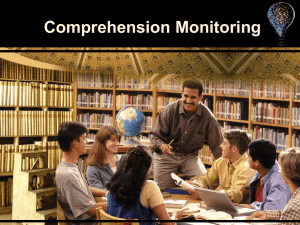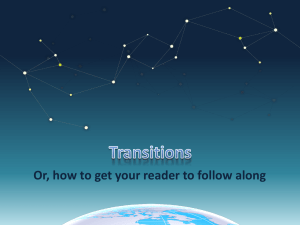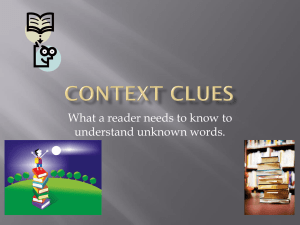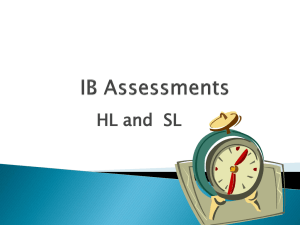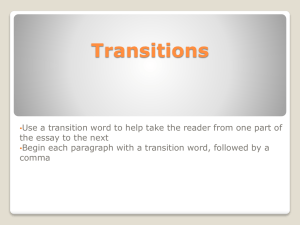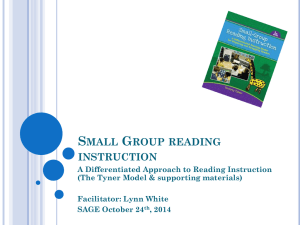Text Complexity Guide
advertisement
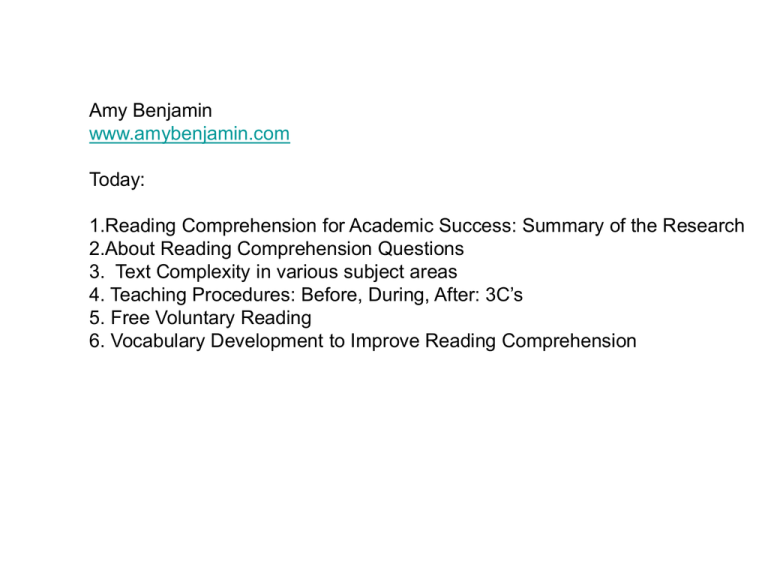
Amy Benjamin www.amybenjamin.com Today: 1.Reading Comprehension for Academic Success: Summary of the Research 2.About Reading Comprehension Questions 3. Text Complexity in various subject areas 4. Teaching Procedures: Before, During, After: 3C’s 5. Free Voluntary Reading 6. Vocabulary Development to Improve Reading Comprehension Improving Reading Comprehension for Academic Success Summary of the Research [1] [1] National Council of Teachers of English, 2008 International Reading Association, 2008 Association for Supervision and Curriculum Development, 2008 Identify two interesting and/or questionable points for discussion. pelaprg grapple Bryan Arlen Remembering the reading material Kinds of unfamiliar vocabulary Kinds of context clues More multisyllabic words More words that are related to each other More words having Y, X, CH (pronounced K), PH More words ending in …osis, …ology, …ity, …ism, …cious Reasons for rereading Pace “Anyway, the fascinating thing was that I read in National Geographic that there are more people alive now than have died in all of human history. In other words, if everyone wanted to play Hamlet at once, they couldn’t, because there aren’t enough skulls!” Extremely Loud, Incredibly Close . Jonathan Foer. Quantitative/Measurable: Sentence length Word length What determines text complexity? Qualitative: Not Measurable: Subtle qualities of text Underlying themes Symbolism Obscurity (rareness) of vocabulary Pre-20C writing style Figurative language Intentional ambiguity; intentionally misleading information Allusions: Literary, Biblical, etc. Long paragraphs Small print; lack of visuals in text Mixing of time frames Having multiple narrators Background knowledge of reader; Task to be done with the reading Text Complexity Guideline Features: Levels of Meaning Most Challenging : Multiple layers of meaning; purposeful ambiguity; multiple interpretations possible Figurative language Metaphor, irony, allusion, symbolism play a significant part in comprehension Purpose Deliberately withheld from the reader; reader has to use interpretative skills to identify it Genre/ Sub-genre (ex: sci fi) Unfamiliar to the reader; has specific hallmarks that reader does not recognize Organization Narration Vocabulary and Language style Goes back and forth in time; withholds chronological information multiple narrators & settings Unreliable first person and/or multiple narrators; reader is expected to question the narrator’s credibility Multiple rare words on every page; pre-20C language style and unfamiliar nouns; long, complicated syntax Source: Adapted from Text Complexity: Raising Rigor in Reading. Douglas Fisher, Nancy Frey, and Diane Lapp. International Reading Association. Moderately Challenging: : Single but complex or abstract meaning; reader expected to infer from implications to some extent Figurative language used to some extent; symbols are obvious and/or explained by the author (ex: blackness for death or despair) Least Challenging : Single and literal meaning; meaning is explicitly stated and signalled (headings, etc.) Language is straightfoward; negligible amount of figurative language Implied but fairly easily identified Stated and repeated explicitly based on the title or context Somewhat unfamiliar to the reader, or easily accessible anyway May be non-linear or have two narrators or multiple settings, but these are cleary signalled Third person narration reader given substantial information about the narrator’s point of view Not an overwhelming number of rare words; modern style, familiar nouns; straightforward syntax Familiar to the reader and consistent with reader expectations Linear, chronological, limited settings; single narrator Third person omniscient or authoritative, credible source of the information Almost entirely common words, simple or easily comprehensible sentences Elements of Text Complexity Science History •subtle meanings •underlying, multiple themes •pre-20C language •charts, graphs, tables •words having more than 4 syllables •long sentences Literature •obscure/rare words used only once in text •figurative language •allusions •small print, lack of visuals •long paragraphs •mixing of time frames Math •multiple narration •high degree of background knowledge assumed •intentional ambiguity • intentionally misleading information •Symbols (as in math/sci) 3 Types of Reading Problems: I. Lack of cognitive abilities: comprehension, vocabulary, word recognition, fluency II. Negative attitudes toward reading III. Lack of flexibility to read different kinds of text; read all texts with the same strategies: pacing, focus, sequence Teaching students to comprehend complex text: Top Step: Test prep: Developing familiarity with the kinds of text and questions Step 3: Specific practice in identifying features of text complexity: metaphor, tone, subtleties, allusion, rare vocab, figurative language, pre 20C, long sentences, long paragraphs Step 2: Vocabulary instruction: implicit (immersion) explicit (analytical) Step 1: Lots of free reading time Text Exemplar (Grade 8) Douglass, Frederick, Narrative of the Life of Frederick Douglass as an American Slave, Written by Himself (1845)

